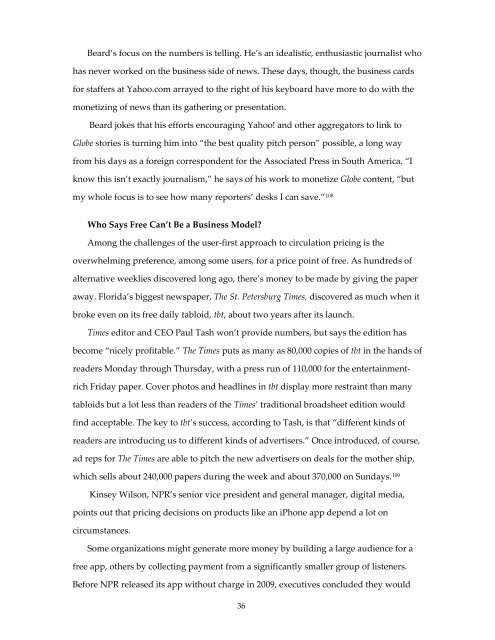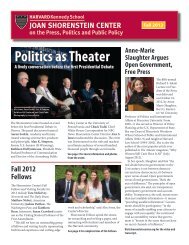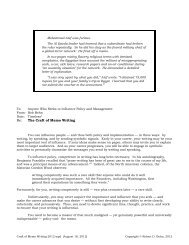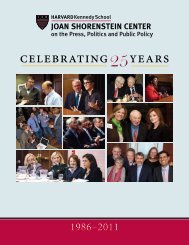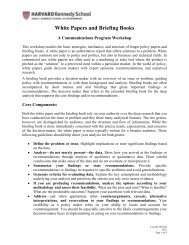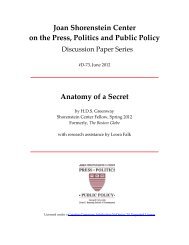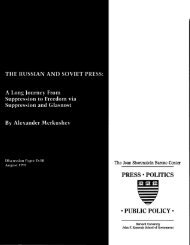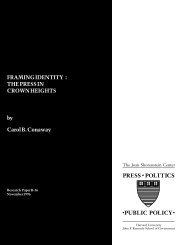A User-First Framework for Sustaining Local News - Harvard ...
A User-First Framework for Sustaining Local News - Harvard ...
A User-First Framework for Sustaining Local News - Harvard ...
You also want an ePaper? Increase the reach of your titles
YUMPU automatically turns print PDFs into web optimized ePapers that Google loves.
Beard’s focus on the numbers is telling. He’s an idealistic, enthusiastic journalist who<br />
has never worked on the business side of news. These days, though, the business cards<br />
<strong>for</strong> staffers at Yahoo.com arrayed to the right of his keyboard have more to do with the<br />
monetizing of news than its gathering or presentation.<br />
Beard jokes that his ef<strong>for</strong>ts encouraging Yahoo! and other aggregators to link to<br />
Globe stories is turning him into “the best quality pitch person” possible, a long way<br />
from his days as a <strong>for</strong>eign correspondent <strong>for</strong> the Associated Press in South America. “I<br />
know this isn’t exactly journalism,” he says of his work to monetize Globe content, “but<br />
my whole focus is to see how many reporters’ desks I can save.” 108<br />
Who Says Free Can’t Be a Business Model?<br />
Among the challenges of the user‐first approach to circulation pricing is the<br />
overwhelming preference, among some users, <strong>for</strong> a price point of free. As hundreds of<br />
alternative weeklies discovered long ago, there’s money to be made by giving the paper<br />
away. Florida’s biggest newspaper, The St. Petersburg Times, discovered as much when it<br />
broke even on its free daily tabloid, tbt, about two years after its launch.<br />
Times editor and CEO Paul Tash won’t provide numbers, but says the edition has<br />
become “nicely profitable.” The Times puts as many as 80,000 copies of tbt in the hands of<br />
readers Monday through Thursday, with a press run of 110,000 <strong>for</strong> the entertainment‐<br />
rich Friday paper. Cover photos and headlines in tbt display more restraint than many<br />
tabloids but a lot less than readers of the Times’ traditional broadsheet edition would<br />
find acceptable. The key to tbt’s success, according to Tash, is that “different kinds of<br />
readers are introducing us to different kinds of advertisers.” Once introduced, of course,<br />
ad reps <strong>for</strong> The Times are able to pitch the new advertisers on deals <strong>for</strong> the mother ship,<br />
which sells about 240,000 papers during the week and about 370,000 on Sundays. 109<br />
Kinsey Wilson, NPR’s senior vice president and general manager, digital media,<br />
points out that pricing decisions on products like an iPhone app depend a lot on<br />
circumstances.<br />
Some organizations might generate more money by building a large audience <strong>for</strong> a<br />
free app, others by collecting payment from a significantly smaller group of listeners.<br />
Be<strong>for</strong>e NPR released its app without charge in 2009, executives concluded they would<br />
36


